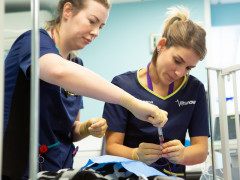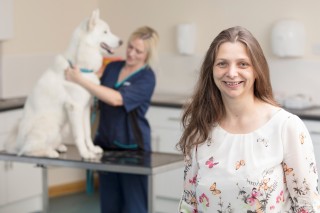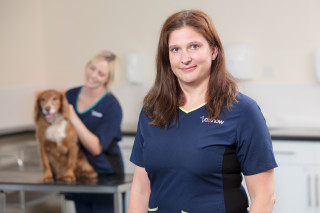Our business bucks national trend with 90% of senior roles held by women
The issue of gender equality has slowly climbed its way up the political ladder of attention.
But the evidence suggests there are still huge strides to be made before women are represented equally on company boards.
Across the UK, just 22% of senior roles are currently held by women – below the global average of 24% – and 25% of British businesses have no women at all in senior management.
Things are just as acute in the female-dominated veterinary profession, where it’s estimated around a quarter of leadership roles are held by women. This is despite females accounting for almost 60% of practising vets and 80% of veterinary degree undergraduates.
At Vets Now, however, the picture is very different. There are female leaders in both senior clinical and non-clinical roles – and plenty of them.
“We rarely shout about this but looking at the gender gap statistics across the veterinary profession and the wider business world it’s something we should be proud of,” said Lisa Robb, marketing and communications director.

Do you want to join our team?
We’ll help you build your career around your lifestyle, not your lifestyle around your career.
Our vacanciesAside from Lisa, there are eight other women on the 10-strong operations board in Amanda Boag (clinical), Patricia Colville (new business), Nicki Daw (customer relations), Johanna Wallace (finance and IT), Donna Kennedy (regional south), Gill Burkhill (regional north), Kirsten McLeod (hospitals) and Sam Prentice (people).
The senior management team is also dominated by females while all nine of the company’s district managers are women as are five of the nine district vets and five of the seven customer relations managers.
A large proportion of the business’s nationwide network of accident and emergency clinics and emergency and specialty hospitals are also run by female senior vets and senior nurse managers. In addition, the vast majority of support functions are led by females.
Conversely, many of what were once considered traditional female roles are held by men. For example, several of the company’s senior vet nurses are male.
But why has Vets Now bucked the trend when it comes to female leaders? According to Lisa, whose background is in digital marketing, it’s simply that people are seen as people and those who want to make a difference are afforded the opportunity to progress – regardless of their gender.
“Our recruitment strategy is simple,” she said. “We recruit the best people for the job. It’s purely down to ability and, just as importantly, their potential to fit in with our culture and ethos.
“We actively target vets and vet nurses – men and women – who aspire to be high achievers and we assure them there is no glass ceiling. Once they’re in the door, we encourage them to take responsibility for their development and to fulfil their potential.
“And we will always be flexible in our approach to supporting those with external responsibilities or commitments.”
Lisa Robb Vets Now Marketing and Communications Director“We recruit the best people for the job. It's purely down to ability and, just as importantly, their potential to fit in with our culture and ethos."
The issue of gender imbalance in the veterinary profession is almost as old as the profession itself. Numbers of women vets only began to rise in the 1920s, and by 1960 they still accounted for less than 5% of the profession.
Today the split is 60/40 in favour of females. However, there remains a far smaller proportion at senior level.
Amanda Boag, clinical director at Vets Now and current president of the RCVS, said: “There are many and varying reasons why women are less likely to end up in leadership positions although these are not unique to the veterinary industry.
“Having said that, the gender gap in veterinary leadership roles is clearly a cause for concern for the profession. It is a source of great pride that Vets Now is bucking this trend and supporting women.
“Traditionally, women have been less likely to put themselves forward for leadership positions due to a lack of confidence. They worry they might not be good enough. So as well as ensuring our roles are flexible, we’ve also worked hard to give our people the confidence to develop.
“A lot of that comes down to the learning culture at Vets Now. It encourages people to learn from their mistakes and to take confidence from that.”

To foster this culture, Vets Now has established an online forum for clinical staff to discuss cases, positive and negative experiences, ethical dilemmas, and valuable research they have come across.
One of the debates on this widely-used platform – started by head of veterinary standards Laura Playforth – centred on whether women are less prepared to take on veterinary leadership roles.
It was prompted by concerns raised by Professor Colette Henry, of the Dundalk Institute of Technology, and came in the wake of a survey which suggested many female vets are disillusioned with their future career trajectory.
Laura, a full-time working mum who has worked her way up the career ladder from emergency vet to district vet to working in a leadership role alongside Amanda Boag, said: “I think, on average, women aren’t as good at selling themselves or appearing as confident as men.
“But times are changing as our company shows. I feel enormously grateful to work for a business which has always supported me in my development and to have had line managers who believed in me more than I believed in myself.
“We have some amazing female role models within the company, both with and without families of their own. It also helps that we have more opportunities for career development for everyone – men and women – than most other businesses within the profession.”

You might also be interested in:
Aoife Reid, head of Vets Now’s Edge induction programmes, is confident increasing numbers of female veterinary leaders will emerge over the next decade.
She said: “When I graduated in Dublin in 2001 our year was still male-dominated but, by then, many other universities had proportionately more women. It means that, as far as numbers are concerned, my generation is the first that’s had a genuinely equal chance to assume leadership roles.
“Many people wait until later in their career to take on those roles so my hope is we will see a surge in female leaders in the next five to 10 years.”
But she added: “There’s no doubt Vets Now has been ahead of the curve on this issue. I’m proud to be part of a business that has so many strong female role models at all levels.”
In one recent gender equality league table, which focused on developed nations, the UK was listed in 13th place, behind the likes of Poland, Slovenia and Canada.
Indeed, the situation has become so acute mainstream political parties have resorted to positive discrimination to address the imbalance – even though they have been instrumental in the numerous high-profile campaigns to close the gender gap.
The Women and Equalities Committee at Westminster has suggested that political parties should be fined if they don’t ensure at least 45% of their candidates are women.
It made the call after citing evidence that with less than a third of women MPs, Britain ranks a lowly 48th in global rankings. If ever a similar league table is drawn up for the veterinary profession, it’s easy to predict which position Vets Now will occupy.
If you’d like to find out more about the career opportunities at Vets Now visit our careers site or call a member of our recruitment team on 01383 807 547.

